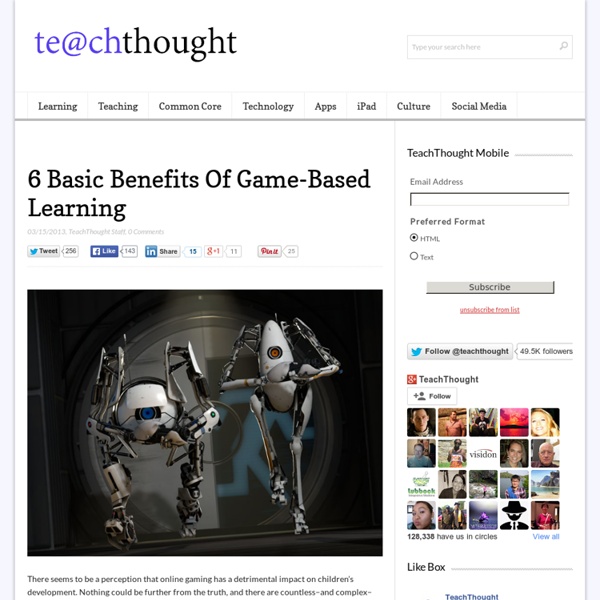How Minecraft Can Be Used To Create A Video Game
Minecraft is not only a standalone video game that creates a digital sandbox for players to play, create, design, and publish thinking, but it also can be used for a different purpose entirely–to create other video games. How is this possible? A few facts to clarify: 1. Minecraft is a video game. 2. 3. 4. The video below also includes four other examples of what can be done with Minecraft, including a television (that seems to work), Connect 4, and an interesting experiment in scale. 3 Steps To Creating A Game With Minecraft Creating a video game with it, then, is as simple as creating the rules to any other “game”: 1. 2. 3. The possibilities for using minecraft in learning are staggering really, perhaps only stunted by the perception of it as “just a game.”
Game-Based Learning? 30 Non-Violent Video Games That Don't Suck
One person’s mushroom stomper is another’s person’s fungus murderer. So it may not be absolutely correct to say that every single one of these games is entirely free from any matter of violence whatsoever. In fact, in Braid, you can indeed “die” falling on spikes. But for the most part, they are indeed non-violent games, and certainly nothing approach the reality of many modern “shooters.” Violence is a matter of degrees if not interpretation. Truth be told, most non-violent games aren’t fun. But there are exceptions, and that list is growing. Whether for game-based learning, or simply for fun to play, any of these games represents an impressive design achievement, and is definitely worth a play. 30 Non-Violent Video Games For Game-Based Learning That Don’t Suck 1. 2. 3. 4. 5. 6. 7. 8. 9. 10. 11. 12. 13. 14. 15. 16. 17. 18. 19. 20. 21. 22. 23. 24. 25. 26. 27. 28. 29. 30. Game-Based Learning?
How Game-Based And Traditional Learning Are Different
There are several big movements underway that are worthy of debate and possible consideration as we look to help education become the 21st century, user-centered, on-demand, engaging, technology-centric activity that it has not been for much of its existence. Game-based learning (GBL), or gamification, is one of the models that commonly gets touted as a cure-all for the problems with education because of the popularity of gaming in our society (New Media Institute). While there are problems with the gamification movement as it currently stands, the model has several areas in which it differs sufficiently from traditional education to make it an intriguing possibility. Authenticity This is one of the most interesting and controversial areas where GBL can separate itself from what we see in the traditional classroom. Games have the potential to allow students to do exactly that. Student Engagement The hidden agenda of games and play is to teach. Creativity and Innovative Thinking
The Difference Between Gamification And Game-Based Learning
The Difference Between Gamification And Game-Based Learning Gamification and game-based learning are each buzzwords (and buzzphrases) in education. Each can offer your classroom something, but many mistake one for the other. Can you tell the difference? The Definition Of Gamification The definition of gamification is the application of game-like mechanics to non-game entities to encourage a specific behavior. What It’s Not Gamification is not game-based learning, nor does it require students to play games, with toys, use electronics. When Does It Make Sense To Use? To encourage a specific response or behaviorTo increase the visibility and perceived importance of otherwise “minor” and less visible actionsTo promote competition; to engage studentsTo help students track their own progress Examples Leaderboards (e.g., Class Valedictorian), badges, trophies, points systems, XP, “unlocking” certain content via mastery of preceding content. Letter grades are a kind of gamification. Learn what? 1. 2.
Free Online Jigsaw Puzzles
ESA LOFT Innovation | Home
Gamestar Mechanic
GameMaker: Studio | YoYo Games
Last updated: 02/04/2019 We (meaning YoYo Games Limited, company number 05260718) use technologies on our website and mobile services (which we'll call the Services) to collect information that helps us improve your online experience. We refer to these technologies, which include cookies, collectively as “cookies.” This policy explains the different types of cookies used on the Services and how you can control them. We hope that this policy helps you understand and feel more confident about our use of cookies. Cookies are small text files that are stored on your computer or mobile device. Below we list the different types of cookies we may use on the Services. Essential Cookies. Essential cookies on the Services may include: Performance Cookies. Performance cookies on this Services may include: Functionality Cookies. Targeting or Advertising Cookies. Banner Advertising On Other Websites Targeting and advertising cookies on this Services may include: Google Adwords Facebook Twitter Google Facebook
About
An overview of Kodu. (Click to play) Kodu lets kids create games on the PC and Xbox via a simple visual programming language. Kodu can be used to teach creativity, problem solving, storytelling, as well as programming. Since Kodu's introduction in 2009, we have visited the White House, teamed up with great groups like NCWIT and DigiGirlz, inspired academic research and been the subject of a book (Kodu for Kids). Kodu for the PC is available to download for free.




The skills developed would be at teacher's dream come true. The key is determining what educational value does the game has. Each game must be evaluated for what the learner needs. How will it enhance learning? Food for thought! by psmeyers Oct 4